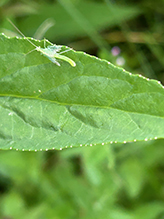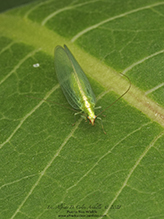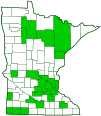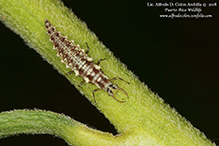weeping green lacewing
(Chrysoperla plorabunda)
Conservation • Description • Habitat • Ecology • Distribution • Taxonomy
|
|
||||||||||||||
Description |
Weeping green lacewing is a widespread, very common, medium-sized, net-winged insect. It occurs in Europe, Asia, North Africa, and North and South America. True to its common name, it is the most common green lacewing worldwide. This is one of four species in the Chrysoperla carnea group that can be reliably separated only by an analysis of their courtship song. However, Chrysoperla plorabunda is the only member of the group that occurs in the Midwest. Adults are ½″ to ¾″ long and have a wingspan of ⅞″ to 1¼″. The body is long and slender, and has a delicate appearance. The thorax and abdomen are pale green and often have a thin, pale yellow stripe above. The antennae are long and thread-like. The compound eyes are gold or copper-colored. On the side of the face (gena) below each compound eye there are two stripes, a reddish stripe above and a dark stripe below. The wings are transparent with a network of pale green veins. The forewing and hindwing are the same size and shape. The subcostal vein (Sc) is not fused with the anterior branch of the radial vein (R1) at the wing tip. The costal cross-veins are not forked. The wings are held roof-like over the body when at rest. Third stage (instar) larvae are alligator-like in appearance, ¼″ to 5 ⁄16″ long, and have long, sickle-shaped mandibles. They have well-developed legs which allow them to move quickly. |
Size |
Total length: ½″ to ¾″ Wingspan: ⅞″ to 1¼″ |
Similar Species |
Habitat |
Open areas: meadows, agricultural crops, and human houses |
Ecology |
Season |
Two or three generations per year: spring to autumn |
Behavior |
Adults are nocturnal, active from sunset to sunrise. They are attracted to lights. They may emit an unpleasant odor when handled. |
Life Cycle |
Overwintering adults become active in the spring. The female lays eggs singly on foliage. She can lay two to five eggs per day and several hundred over her lifetime. The eggs are oval, pale green, and held at the end of long, slender stalks. They hatch in three to six days and the larvae pass through three instars in two to three weeks. They pupate in a silk, pea-shaped cocoon. Adults emerge in ten days to two weeks. There are at least two or three generations per year. In the fall, adults of the last generation become straw-colored. They group together in leaf litter usually at the edge of a field and enter a state of suspended development (diapause). |
Larva Food |
Mostly aphids, but also many species of insects and arachnids, including adult aphids, spider mites, thrips, and whiteflies; eggs of leafhoppers, moths, and leafminers; and larvae of butterflies, moths, and beetles. |
Adult Food |
Flower nectar and pollen, and aphid honeydew |
Distribution |
||
|
Sources Biodiversity occurrence data published by: Minnesota Biodiversity Atlas (accessed through the Minnesota Biodiversity Atlas Portal, bellatlas.umn.edu, 7/20/2025). According to BugGuide.net: By range, C. plorabunda is the only member of the carnea-group currently reported from the central and southeastern US. Apart from a population of C. downesi in the area from New York to New Hampshire, C. plorabunda is the only species in the group with known occurrence in the eastern half of the US. The map at left includes all BugGuide.net and iNaturalist.org observations in the carnea-group currently reported from Minnesota. Also according to BugGuide.net: True Chrysoperla carnea does not occur in North America and is exclusively a European species (itself not identifiable from photographs alone and requiring song analysis). Many web resources erroneously report this species due to using a currently invalidated definition of the species. The map at left includes one GBIF observation of Chrysoperla carnea currently reported from Nobles County Minnesota. |
|
| 7/20/2025 | ||
Occurrence |
||
Widespread and very common |
||
Taxonomy |
|
Order |
Neuroptera (antlions, lacewings, and allies) |
Suborder |
Hemerobiiformia (lacewings and allies) |
Family |
|
Subfamily |
Chrysopinae (typical green lacewings) |
Tribe |
|
Genus |
Chrysoperla (common green lacewings) |
no taxon |
|
Subordinate Taxa |
|
|
|
Synonyms |
|
Chrysopa californica Chrysopa illinoiensis Chrysopa plorabunda Chrysopa plorabunda ssp. californica Chrysopa plorabunda var. californica Chrysopa pseudographa Chrysopa robertsonii Chrysopa simplex Chrysoperla californica |
|
Common Names |
|
weeping green lacewing |
|
Glossary
Gena
In insects: The area between the compound eye and the mandible; the cheek. In birds: The area between the the angle of the jaw and the bill; the feathered side (outside) of the under mandible. Plural: genae.
Instar
The developmental stage of arthropods between each molt; in insects, the developmental stage of the larvae or nymph.
Visitor Photos |
||
Share your photo of this insect. |
||
This button not working for you? |
||
Lucy Morrissey |
 |
I saw this insect in our Eden Prairie backyard today - is it a type of mayfly? |
Alfredo Colon |
||
 |
||
MinnesotaSeasons.com Photos |
||
|
||
|
||

Slideshows |
|

Visitor Videos |
||
Share your video of this insect. |
||
This button not working for you? |
||
|
Other Videos |
||
|

Visitor Sightings |
||
Report a sighting of this insect. |
||
This button not working for you? |
||
| Alfredo Colon 6/7/2021 |
Location: Woodbury, Minnesota |
| Alfredo Colon 7/9/2018 |
Location: Woodbury, Minnesota |
MinnesotaSeasons.com Sightings |
||
|

Created: 4/19/2021 Last Updated: © MinnesotaSeasons.com. All rights reserved. |




